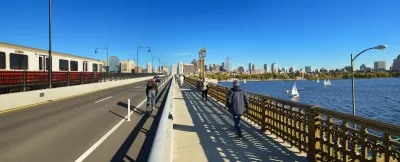A new report assesses the city’s progress halfway through implementation of the ‘Go Boston 2030’ long-range transportation plan.

Writing in Streetsblog Mass, Christian MilNeil describes the progress made by the city of Boston on its Go Boston 2030 plan, which “set goals for the city to reduce the number of car trips inside the city's limits by half and eliminate serious injuries and deaths from traffic violence by the end of this decade.”
A progress report from the LivableStreets Alliance expresses doubt that the city can meet its goal of cutting greenhouse gas emissions from vehicles in half. “According to the city's most recent data, motor vehicles in the city were still pumping 1.9 million metric tons of greenhouse pollution into the atmosphere in 2019, the most recent year for which city-level data is available,” a “statistically insignificant” change from 2005 levels.
Boston made more significant strides in street safety, according to the report. “The city has actually met its 2017 target to reduce pedestrian and bicycle-related collisions by at least 30 percent, seven years ahead of schedule.” The report also praised the city’s “strong progress” on installing protected bike infrastructure and bringing public spaces into Americans With Disabilities Act (ADA) compliance.
Jascha Franklin-Hodge, Boston's Chief of Streets, said in a press release that the city will “launch an official update of the Go Boston 2030 plan to re-focus the city's goals” and adjust to post-pandemic mobility patterns and needs.
FULL STORY: Halfway to 2030, How’s ‘Go Boston’ Going?

Study: Maui’s Plan to Convert Vacation Rentals to Long-Term Housing Could Cause Nearly $1 Billion Economic Loss
The plan would reduce visitor accommodation by 25,% resulting in 1,900 jobs lost.

North Texas Transit Leaders Tout Benefits of TOD for Growing Region
At a summit focused on transit-oriented development, policymakers discussed how North Texas’ expanded light rail system can serve as a tool for economic growth.

Why Should We Subsidize Public Transportation?
Many public transit agencies face financial stress due to rising costs, declining fare revenue, and declining subsidies. Transit advocates must provide a strong business case for increasing public transit funding.

How to Make US Trains Faster
Changes to boarding platforms and a switch to electric trains could improve U.S. passenger rail service without the added cost of high-speed rail.

Columbia’s Revitalized ‘Loop’ Is a Hub for Local Entrepreneurs
A focus on small businesses is helping a commercial corridor in Columbia, Missouri thrive.

Invasive Insect Threatens Minnesota’s Ash Forests
The Emerald Ash Borer is a rapidly spreading invasive pest threatening Minnesota’s ash trees, and homeowners are encouraged to plant diverse replacement species, avoid moving ash firewood, and monitor for signs of infestation.
Urban Design for Planners 1: Software Tools
This six-course series explores essential urban design concepts using open source software and equips planners with the tools they need to participate fully in the urban design process.
Planning for Universal Design
Learn the tools for implementing Universal Design in planning regulations.
City of Santa Clarita
Ascent Environmental
Institute for Housing and Urban Development Studies (IHS)
City of Grandview
Harvard GSD Executive Education
Toledo-Lucas County Plan Commissions
Salt Lake City
NYU Wagner Graduate School of Public Service





























